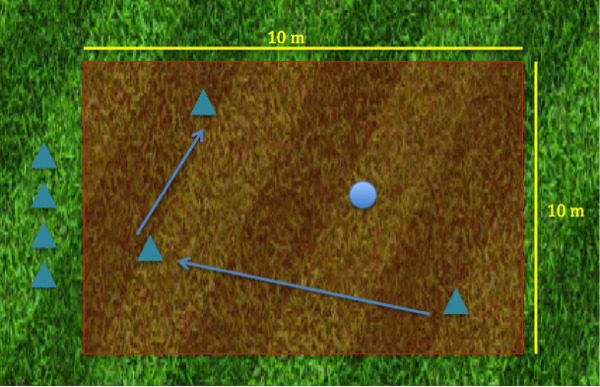Group (8-10) informal football training
At this point, drills and training very much looks like the small-training pods that we covered a couple months back, as clubs were still aiming to have a season, and train under certain number restrictions.
So you can check out a detailed discussion of that here and here.
Additionally, it is unlikely that small private training sessions will involve more than 6 people particularly often (at least consistently), and that is of course assuming that they are allowed to.
But it is still worth adding a few extra simple ideas that exist for these size groups, which once again, can be done in combination with the other ideas already covered for smaller groups.
3 v 1 Handball maintain possession
-Pretty rudimentary and basic handball possession game, but the key is in the quick organization and transition of the drill.
-The larger number of players now, allows for these sorts of conditioning and skill games to be executed at a higher quality (due to rest) and a greater level of organisation
-4 players begin, with 4 standing as reserves waiting for the change over.
-Timer is set for a short and intense bout (20 seconds, building eventually to 30)
-The 3 players must continue to work and move to keep the ball away from the 1 defender for the duration of the repetition
-Once the 20-30 seconds is up, the 4 swap with the 4 waiting on the outside.
-This works best with a set timer – on phone or an actual timer (20 second efforts paired with 5-7 seconds of changeover time.)
-Naturally take it in turns for who is the defender, meaning 4 repetitions per group before everyone has cycled through.
-Complete 8 repetitions each before a rest (16 total)
-With 20 second repetitions and 7 seconds transition, this is less than 8 minutes of actual time, with more than half of it rest time. However the intensity is enormously high (if done properly) and is a very effective way of combining the condition work, with hopefully quality movement/skill execution.
3 v 1 Handball + kick – end-to-end
Building on the 3 v 1 handball, with an end to end kick + run

-3 v 1 at each end
-While contest occurs at one end, 3 attackers wait down the other end, with the defender in the middle zone
-Attackers (triangles) must complete 5 hand passes (for example) within that zone around the defender
-Once completing the required number, the player with the ball progresses into the middle zone and delivers a kick to the opposite end (ideally to a lead, rather than just lobbing it up, since there is no pressure).
-The defender for the other end is in the middle zone providing a ‘token opposition’ to kick over, rather than any real pressure.
-Only once this defender enters the end zone to defend the other end can the hand - passes at the other end commence.
-Continue to work the ball end to end in such a manner for required repetitions.
-Rotate the defender on each effort (so ball will travel up and back 4 times before everyone has cycled through.)
Competitive Goal snap

-2 players at 50m feeding the ball to the contest
-2 players about 15-20 meters from goal (blue) in aerial duel – although there should be some body to body work, the 2 are essentially working together to bring the ball to feet
-2 players in the crumb contest (yellow) – the real focus of this drill – who compete and snap the goal (hopefully)
-2 players stationed behind the goal, who return the ball back to the 50.
-Perform 3 contests, before rotating the positions through once each (12 total.)
-Keep track of the scores from each head-to-head. In other words, you may win 2 ground ball contests, yet kick 0.2, while your opponent only won 1, but managed to convert the goal. They win.
Alternatively if you have an extra number or 2, make the contest a 2 v 2, where the ground ball winner fires out a hand pass wide for a quick snap.

Normal drills as conditioning
Similar to the standard lane work being used, in a similar vain, the closed-chain drills (kicking to pre-designated cones/non-competitive work) of any sort that you do at normal training make simple-to-perform drills.
4-5 points, involving combination of kick-mark-handball, shot at goal, etc. These types of drills are simple and unlimited, and you all would have different favourites that your coaches go to. Throw these in, however add a timer – go for a set time, and aim for as many rounds as possible. Execute at maximum intensity for 5 minutes, keep count, rest 1 minute, then repeat. Minimise the errors.
3 man weave (3 groups of 3, add a defender in the middle) variations. Again, set timer, set targets, have a purpose rather than just going through the motions. The more work at high intensity getting done, the less there needs to be a focus on extra running.
as previously mentioned, the drills that have been put forward have endeavoured to combine speed and agility and conditioning in a football setting. However isolating physical components initially is good – this is just for illustration purposes. There are plenty of closed/isolation style conditioning things that you can do – and in fact a combination works well. Also adding in the football element should be built up to (as discussed in more detail in a previous article.)
There are many options with how you can approach this. We are very much only scratching the surface here. Suffice to say that continue to perform a variant of football training where you can. Do your strength and power training where you can. And get the enjoyment factor there out of semi-structured and informal football.
Strength Coach

